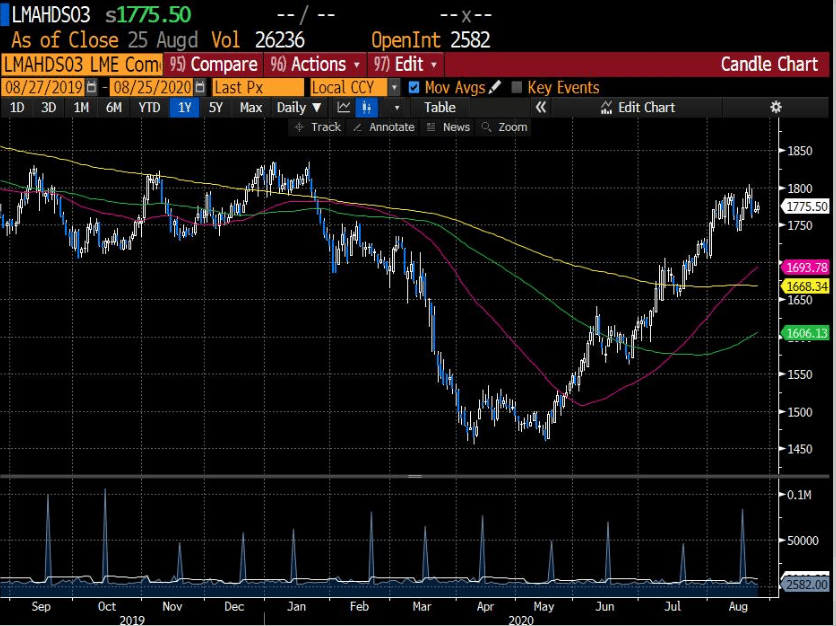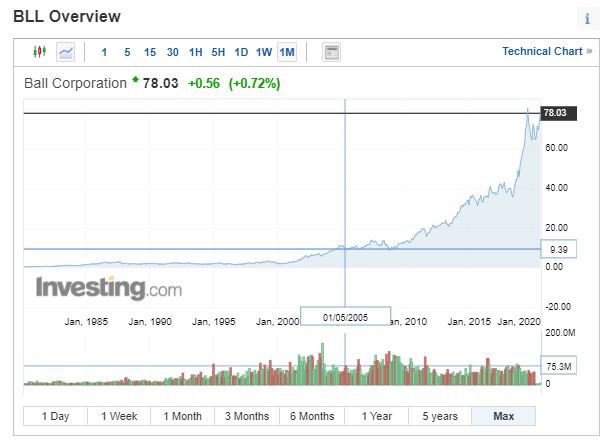The Pandemic has created supply shortage in various industries. Aluminum can is one of them. Indeed, with drink consumption moving from bars to the couch, the can industry is witnessing massive demand at a time the capacity to produce the cans is lacking. Below, we review this corona-economic story and look at one stock which is benefiting from the surge in eco-friendly aluminum can demand.
Between the end of January and mid-April, Aluminum prices tumbled more than 20% as the coronavirus pandemic was hitting global metals demand (see chart below).
Automotive applications are the main end users of Aluminum and the sector was enduring major disruptions to its supply chain. The US market saw the removal of an estimated 33,000 vehicles per day from production as all major auto producers across the country halted operations in response to government mandates and concerns over the welfare of workers.
Because the transportation sector is the largest end user of aluminum, accounting for around 35% of aluminum consumption, it is easy to see why so many market participants expressed concern over the lingering effects coronavirus would have on the health of the industry.
Chart: Aluminum last 12 months (source: Bloomberg)

US aluminum producers saw a notable drop in demand, and in response halted production intermittently, or were running at reduced capacity (between 30% and 40% for some of them). The end of May brought auto restarts, but only at reduced capacities as companies strived to make their facilities safe and ramp up production.
Despite the negative effects seen in the US metals markets, one sector in particular has actually benefited from quarantine and stay-at-home orders – the US beverage can industry.
Sales of aluminum drink cans soared 24% in March at the height of lockdowns. They popped over 16% in April, May, and June as demand stayed very strong.
In the US, 25% of sales are on premise, meaning in a bar or restaurant, while the bulk of cans are consumed off premise, according to one beer maker. When the pandemic started, that on-premise number dropped more than 90% and off-premise went up almost the same.
As beer and soda consumption shifts from restaurants to homes during the COVID-19 pandemic, beverage companies and can makers are struggling to keep up with demand as a shortage of aluminum cans is crimping supplies of certain drinks, industry officials said.
Much like manufacturers weren't prepared for a sudden rush of Americans buying toilet paper in the early days of the pandemic, can makers and beverage companies weren't ready for drink consumption to go from the tap to the home.
Canned beverage demand was up 8.3% in the first quarter, with canned beer rising 6.7% and soft drinks up 9.3%, according to the Can Manufacturers Institute.
"The can industry is working 24/7 on meeting the unprecedented demand," said Robert Budway, president of the Can Manufacturers Institute, the industry's trade association.
The raw material for aluminum can production is not in short supply. As shown on the Aluminum chart, price has been recovering since May but haven’t reached all-time highs. Indeed, it is not Aluminum which is lacking – but the capacity to produce the cans.
Let’s keep in mind that the aluminum beverage can-manufacturing industry was already seeing unprecedented demand for this environmentally friendly container prior the COVID-19 pandemic. Many new beverages are coming to market in cans, and other long-standing can customers are moving away from plastic bottles due to ongoing environmental concerns around plastic pollution. Consumers also appear to be favoring the portability and storability of cans as they spend more time at home.
The spokesperson of a metal packaging leading company said they experienced increasing demand for aluminum cans before COVID-19 from a surge of interest in hard seltzer and sparkling water. COVID-19 created an "unprecedented surge in demand and short supply of certain canned drinks.
Can manufacturers announced plans to build at least three factories within the next 18 months, but that won't solve the immediate supply issues.
True, Aluminum cans have 73% recycled content, most of which comes straight from used beverage cans (UBC). However, US generation of scrap has declined due to the ongoing pandemic, creating this void in the market. The scrap market is seeing substantial tightness, as both consumer and industrial flows have dropped substantially. With deposit states – those with container deposit laws designed to reduce litter and boost recycling – shut down for several months, less UBC scrap has been coming back into the supply chain. Some market participants say a can shortage could last into the fourth quarter.
While the US typically consumes its own UBC scrap, can makers say they need to import cans to keep up with demand. Given the shortage, consumer packaged goods companies have been actively looking at options from Mexico and as far away as Brazil because in both of those markets demand has dropped.
How investors can be exposed to this theme
Ball Corporation (ticker: BLL) is an American company headquartered in Broomfield, Colorado. It is best known for its early production of glass jars, lids, and related products used for home canning. Since its founding in Buffalo, New York in 1880, the Ball company has expanded and diversified into other business ventures, including aerospace technology (16% of Sales). It eventually became the world's largest manufacturer of recyclable metal beverage and food containers. Ball produces cans for large companies like Coca-Cola. While being the #1 can maker, they weren’t ready to meet the demand. They are adding two production lines in Texas and Georgia to keep up with demand. While both lines have the capacity to produce billions cans a year, they will still have to import 2 billion of cans from abroad to meet domestic demand.
The company has a market capitalization of around $25 billion and revenues over $11 billion. A long-term chart of the stock is shown below.
Chart: Ball Corp (source: www.investing.com)






